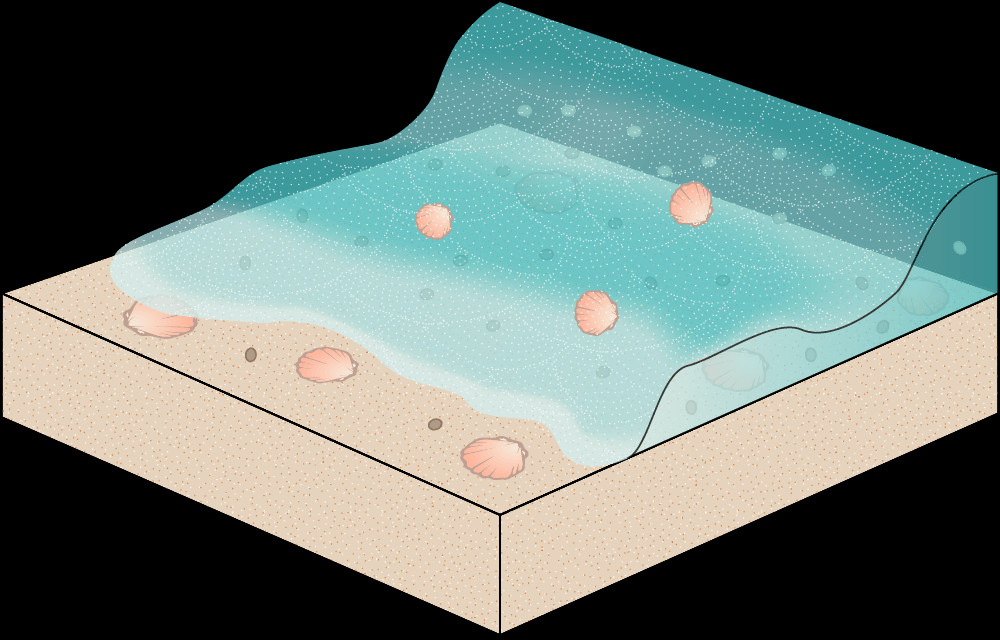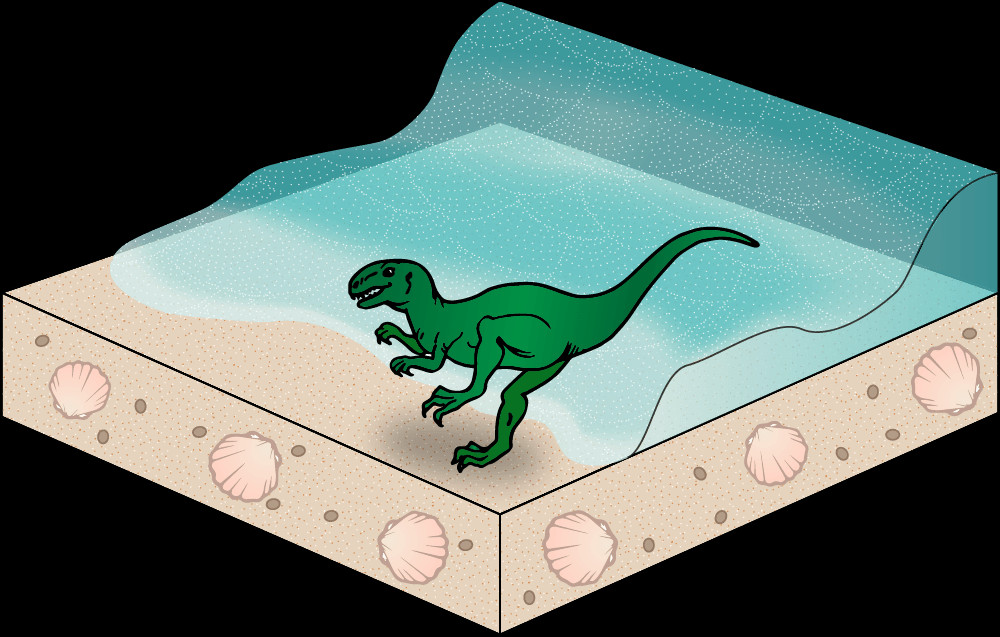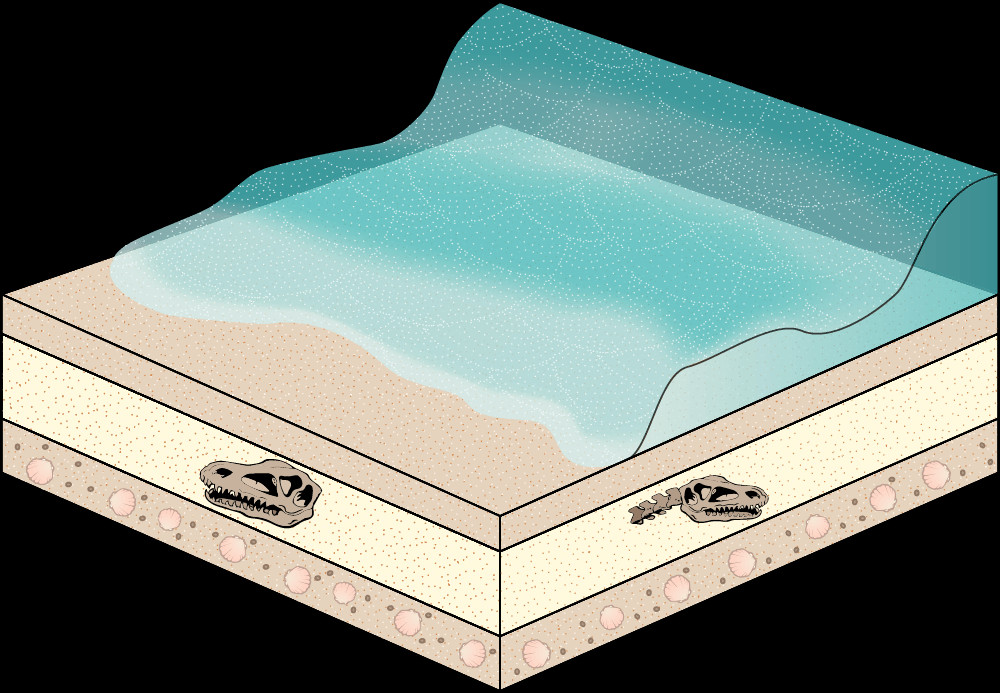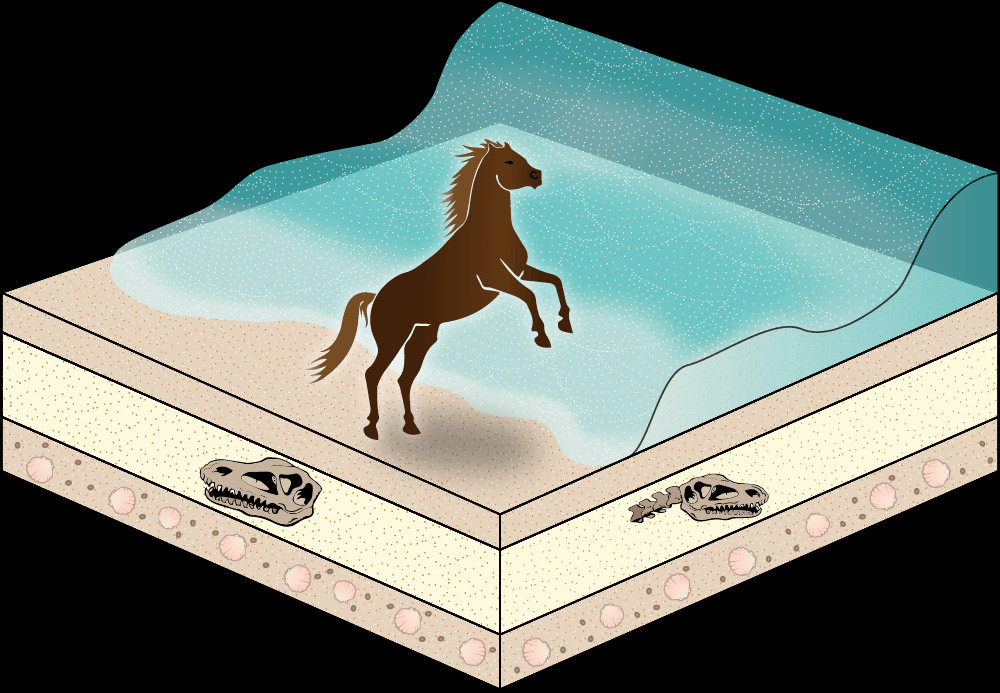Fossils are generally not found in igneous rocks, as these rocks form from molten material, which would destroy organic remains; however, under specific conditions, fossils can be found near igneous rock formations within surrounding sedimentary layers. Rockscapes.net is here to provide insight on how fossils and igneous rocks can coexist within the earth’s geological history, offering a clearer picture of these rare occurrences in the rock and stone landscape. Delve into the intricacies of rock formations with Rockscapes.net, where we explore geological phenomena, fossilization processes, and the unique integration of natural stone into both landscapes and creative designs.
1. What Types Of Rocks Can Fossils Be Found In?
Fossils are primarily found in sedimentary rocks. These rocks, such as sandstone, limestone, and shale, form from accumulated sediments like sand, mud, and organic matter that create a favorable environment for fossil preservation. The gradual layering and compression of these sediments over millions of years provide a protective encasement for organic remains, allowing fossilization to occur. Igneous rocks, formed from cooled magma or lava, and metamorphic rocks, altered by extreme heat and pressure, typically do not contain fossils due to the destructive conditions of their formation processes.
1.1 Sedimentary Rocks: The Primary Fossil Carriers
Sedimentary rocks are the most common hosts for fossils. The process of sedimentation allows for the gradual burial of organic material, protecting it from decay and erosion. As layers of sediment accumulate, the pressure from above compresses the lower layers into solid rock, a process known as lithification. This process can preserve the remains of plants and animals as fossils.
Common Types of Sedimentary Rocks That Contain Fossils:
| Rock Type | Description | Common Fossils Found |
|---|---|---|
| Sandstone | Formed from cemented sand grains, often found in beach or desert environments | Fossilized footprints, burrows, and shells |
| Limestone | Primarily composed of calcium carbonate, often formed in marine environments | Marine invertebrates such as corals, shellfish, and algae |
| Shale | Fine-grained rock formed from compressed mud or clay | Plant fossils, fish fossils, and small marine organisms |
| Coal | Formed from accumulated plant matter in swampy environments | Fossilized leaves, tree trunks, and other plant remains |
| Conglomerate | Composed of rounded pebbles and gravel cemented together | Can contain fragmented fossils mixed with other rock debris |
| Siltstone | A fine-grained sedimentary rock similar to shale but with slightly larger particles | Similar to shale, with plant impressions and smaller marine organism fossils common |
1.2 Why Are Fossils Rare in Igneous Rocks?
Igneous rocks form under conditions that are generally destructive to organic material. The extreme heat of magma or lava, ranging from 700 to 1,300 degrees Celsius, incinerates organic matter, preventing fossilization. Additionally, the rapid cooling of these rocks can trap gases and create a crystalline structure, further hindering the preservation of fossils.
While it is exceedingly rare, there are documented instances where fossils have been found in close proximity to or within certain types of igneous formations. These situations usually involve specific conditions where organic material was rapidly encased by volcanic ash or lava flows that cooled quickly, minimizing thermal decomposition.
Unusual Cases of Fossils Near Igneous Rocks:
- Volcanic Ash Deposits: Fine volcanic ash can bury organisms rapidly, similar to sedimentary processes, leading to fossilization before complete decomposition.
- Lava Casts: When lava flows over organic material like trees, it can create a mold as the organic material burns away, leaving a cast of the original form.
1.3 Metamorphic Rocks: Transformation and Fossil Distortion
Metamorphic rocks are formed when existing rocks are transformed by heat, pressure, or chemical processes. These conditions are typically too extreme for fossil preservation, often distorting or obliterating any original organic structures. The intense pressure and heat can recrystallize minerals, changing the rock’s composition and texture, which usually destroys any fossils present.
However, some metamorphic rocks, such as marble (metamorphosed limestone), may retain faint traces of fossils if the original sedimentary rock contained a high concentration of organic material.
2. What Are The Geological Processes That Favor Fossil Formation?
Several geological processes must align to create conditions favorable for fossil formation. Rapid burial, protection from scavengers and decomposers, and the presence of hard body parts significantly increase the likelihood of fossilization.
2.1 Rapid Burial: A Race Against Decomposition
Rapid burial is crucial for fossil formation. When an organism dies, it is immediately vulnerable to scavengers, decomposers, and environmental elements that can quickly break down organic material. Rapid burial in sediment, such as mud, sand, or volcanic ash, protects the remains from these destructive forces, providing a stable environment for fossilization to begin.
2.2 Sedimentation: Layer Upon Layer of Protection
Sedimentation is the process by which layers of sediment accumulate over time. These layers provide physical protection and maintain consistent chemical conditions, essential for long-term preservation. The type of sediment also plays a role. Fine-grained sediments like mud and silt can capture intricate details of an organism, while coarser sediments like sand may provide better structural support.
2.3 Mineralization: Turning Organic Matter into Stone
Mineralization is the process by which organic material is replaced by minerals, effectively turning the remains into stone. This can occur in several ways:
- Permineralization: Minerals fill the pores and spaces within the original structure.
- Replacement: The original material is gradually replaced by minerals, molecule by molecule.
- Adpression: The fossil gets squashed.
2.4 Anaerobic Conditions: Slowing Decomposition
Anaerobic conditions, where oxygen is limited or absent, can significantly slow down decomposition. This is particularly important in environments like swamps, deep ocean basins, and sediment layers rich in organic matter. The lack of oxygen inhibits the activity of aerobic bacteria and other decomposers, giving mineralization a chance to occur before the organic material is completely destroyed.
3. Understanding Igneous Rock Formations
Igneous rocks are classified based on their formation process, mineral composition, and texture. These rocks originate from magma or lava and can be categorized into intrusive and extrusive types.
3.1 Intrusive Igneous Rocks: Slow Cooling Beneath the Surface
Intrusive igneous rocks form when magma cools slowly beneath the Earth’s surface. This slow cooling allows large crystals to form, resulting in a coarse-grained texture. Granite and diorite are common examples of intrusive igneous rocks. Because they form deep underground, they almost never contain fossils.
3.2 Extrusive Igneous Rocks: Rapid Cooling Above Ground
Extrusive igneous rocks form when lava cools quickly on the Earth’s surface. This rapid cooling results in a fine-grained or glassy texture due to the small size or absence of crystals. Basalt and obsidian are typical examples of extrusive igneous rocks. Similar to intrusive rocks, the high temperatures involved prevent fossil preservation.
3.3 The Impact of Heat and Pressure on Organic Material
The intense heat and pressure involved in the formation of igneous rocks are highly destructive to organic material. Temperatures ranging from 700 to 1,300 degrees Celsius are sufficient to incinerate organic remains, while the pressure can crush and deform any surviving structures. This harsh environment makes it virtually impossible for fossils to form within igneous rocks.
4. Case Studies: Exceptional Fossil Finds Near Igneous Formations
While fossils are rarely found directly within igneous rocks, there are exceptional cases where fossils have been discovered in close proximity to igneous formations. These finds often involve specific conditions that allowed for rapid burial and protection of organic material.
4.1 The Volcanic Ash Beds of Pompeii, Italy
The ancient city of Pompeii was buried by a massive eruption of Mount Vesuvius in 79 AD. The volcanic ash and debris rapidly entombed the city and its inhabitants, preserving remarkably detailed casts of people, animals, and buildings. While these are not technically fossils, they represent a form of preservation due to the rapid burial by volcanic material.
4.2 The Petrified Forest National Park, Arizona, USA
Petrified Forest National Park is famous for its stunning petrified wood, formed when trees were buried by sediment and volcanic ash millions of years ago. The volcanic ash provided a rich source of silica, which gradually replaced the organic material of the trees, turning them into colorful quartz crystals. This permineralization process preserved the structure of the wood in exquisite detail. Arizona State University’s School of Earth and Space Exploration has conducted extensive research on the petrification process, providing valuable insights into the geological conditions that favor this type of fossilization.
4.3 Agate Fossil Beds National Monument, Nebraska, USA
Agate Fossil Beds National Monument contains a rich deposit of Miocene-era mammal fossils. While the fossils are found in sedimentary rock layers, the region’s geological history includes volcanic activity. The presence of volcanic ash layers interspersed with the sedimentary deposits indicates that volcanic eruptions played a role in the environment where these fossils were formed.
5. How To Identify Rocks
Identifying rocks is essential for understanding their potential to contain fossils and for landscape design. There are three primary types of rocks. Sedimentary rocks are the most likely to contain fossils, while igneous and metamorphic rocks rarely do.
5.1 Identifying Sedimentary Rocks
Sedimentary rocks are formed from the accumulation and cementation of sediments. They are often characterized by visible layers or grains.
Key Characteristics of Sedimentary Rocks:
- Layering: Sedimentary rocks often exhibit distinct layers or bedding.
- Grains: Visible grains of sand, silt, or clay may be present.
- Fossils: Sedimentary rocks are the most likely to contain fossils.
- Porosity: Many sedimentary rocks are porous, allowing water to pass through.
5.2 Identifying Igneous Rocks
Igneous rocks are formed from the cooling and solidification of magma or lava. They are often hard and dense.
Key Characteristics of Igneous Rocks:
- Crystalline Structure: Igneous rocks often have a crystalline structure, with interlocking crystals.
- Lack of Layering: Igneous rocks typically do not exhibit layering.
- Hardness: Igneous rocks are generally hard and durable.
- Vesicles: Some igneous rocks may contain vesicles (small holes) formed by trapped gas bubbles.
5.3 Identifying Metamorphic Rocks
Metamorphic rocks are formed when existing rocks are transformed by heat, pressure, or chemical processes. They often have a foliated or banded appearance.
Key Characteristics of Metamorphic Rocks:
- Foliation: Metamorphic rocks may exhibit foliation, with parallel alignment of minerals.
- Banding: Alternating bands of light and dark minerals may be present.
- Distorted Structures: Metamorphic rocks may show distorted or folded structures.
- Hardness: Metamorphic rocks are generally hard and dense.
6. Using Rocks in Landscaping
Incorporating rocks into landscape design can add texture, color, and natural beauty to outdoor spaces. The choice of rocks depends on the aesthetic goals, environmental conditions, and functional requirements of the landscape. Rockscapes.net excels at providing a variety of rocks suitable for any landscape design.
6.1. Selecting the Right Type of Rock for Your Project
The type of rock you choose for your landscape project should complement the overall design and meet specific functional needs.
Popular Types of Rocks for Landscaping:
| Rock Type | Description | Ideal Uses |
|---|---|---|
| River Rock | Smooth, rounded stones that come in various sizes and colors | Garden pathways, decorative ground cover, drainage solutions |
| Flagstone | Flat, sedimentary rocks that can be used for paving and wall construction | Patios, walkways, retaining walls |
| Boulders | Large, natural stones that add a dramatic and rugged element to landscapes | Focal points, natural seating, retaining walls |
| Lava Rock | Lightweight, porous rock that comes in various colors, including red, brown, and black | Mulch, drainage, planting beds |
| Granite | Durable, crystalline rock that adds a touch of elegance to landscapes | Paving, edging, water features |
| Decomposed Granite | Small, granular rocks that are ideal for pathways and permeable ground cover | Pathways, driveways, erosion control |
| Quartzite | A hard, metamorphic rock that adds elegance to landscapes | Decorative gravel, pathways, water features |
| Limestone | Light-colored rocks, often used for their aesthetic appeal | Garden walls, decorative gravel, pathways |
6.2. Designing with Rocks: Aesthetics and Functionality
When designing with rocks, consider both the aesthetic appeal and the functional benefits. Rocks can be used to create visual interest, define spaces, and solve practical problems such as erosion control and drainage.
Design Ideas for Landscaping with Rocks:
- Rock Gardens: Create a rock garden with a variety of rock sizes, shapes, and textures, complemented by drought-tolerant plants.
- Pathways: Use flagstone or river rock to create winding pathways through your garden.
- Water Features: Incorporate rocks into water features such as ponds, streams, and waterfalls to create a natural and soothing ambiance.
- Retaining Walls: Build retaining walls with large boulders or flagstone to prevent erosion and create terraced planting beds.
- Edging: Use rocks to define the edges of planting beds, pathways, and lawns, adding a clean and polished look to your landscape.
6.3. Sourcing Rocks: Where to Find Quality Materials
Sourcing high-quality rocks is crucial for ensuring the success and longevity of your landscape project.
Reliable Sources for Landscaping Rocks:
- Local Quarries: Local quarries offer a wide selection of natural stones at competitive prices.
- Landscape Supply Stores: Landscape supply stores carry a variety of rocks specifically for landscaping purposes.
- Rockscapes.net: Rockscapes.net provides a wide selection of high-quality rocks and stones, catering to diverse landscaping needs and aesthetic preferences. With a vast inventory of natural stones, Rockscapes.net makes it easy to find the perfect materials for your project. Rockscapes.net is located at 1151 S Forest Ave, Tempe, AZ 85281, United States. Contact them at +1 (480) 965-9011 or visit their website at rockscapes.net for more information.
7. Preserving Geological Heritage in Your Landscape
Incorporating rocks into your landscape is not just about aesthetics; it’s also an opportunity to preserve geological heritage and connect with the natural history of your region.
7.1. Using Native Rocks to Reflect Local Geology
Using rocks native to your region can create a landscape that reflects the local geology and natural environment. This approach not only enhances the aesthetic appeal of your landscape but also supports local ecosystems by providing habitat for native plants and animals.
Benefits of Using Native Rocks:
- Authenticity: Native rocks create a landscape that is authentic and reflective of the local environment.
- Sustainability: Using native rocks reduces the environmental impact associated with transporting materials from distant locations.
- Ecological Support: Native rocks provide habitat for native plants and animals, supporting local biodiversity.
7.2. Creating Educational Rock Displays
Consider creating educational rock displays in your landscape to showcase the geological history of your region. These displays can feature labeled specimens of different rock types, along with information about their formation and significance.
Elements of an Educational Rock Display:
- Rock Specimens: Collect a variety of rock specimens that are representative of the local geology.
- Labels: Label each specimen with its name, formation process, and age.
- Information Panels: Provide information about the geological history of the region and the significance of each rock type.
- Interactive Elements: Incorporate interactive elements such as maps, diagrams, and touchable specimens to engage visitors.
7.3. Ethical Rock Sourcing and Conservation
Ethical rock sourcing is essential for preserving geological heritage and minimizing environmental impact. Choose suppliers who follow sustainable practices and respect the natural environment.
Principles of Ethical Rock Sourcing:
- Sustainability: Choose suppliers who follow sustainable mining and quarrying practices.
- Environmental Protection: Support suppliers who minimize environmental impact and restore disturbed sites.
- Community Engagement: Engage with local communities and respect their cultural heritage.
- Transparency: Demand transparency in the sourcing and processing of rocks.
8. Rockscapes.Net: Your Partner in Landscape Design
At Rockscapes.net, we are passionate about helping you create stunning landscapes that celebrate the beauty and diversity of natural stone. Whether you’re looking for inspiration, guidance, or high-quality materials, we are here to support you every step of the way.
8.1. Explore Our Wide Selection of Rocks and Stones
Rockscapes.net offers a wide selection of rocks and stones to suit any landscape design. From river rock and flagstone to boulders and lava rock, we have the perfect materials to bring your vision to life.
8.2. Get Inspired with Our Design Ideas and Resources
Our website features a wealth of design ideas, tips, and resources to help you create the landscape of your dreams. Explore our galleries of stunning rock landscapes, read our informative articles, and download our free design guides.
8.3. Connect with Our Team of Experts
Our team of experts is here to answer your questions, provide personalized recommendations, and help you find the perfect rocks for your project. Contact us today to schedule a consultation or visit our showroom to see our products in person.
9. Conclusion: Embrace the Beauty of Rocks
While fossils are generally not found within igneous rocks due to their volcanic origins, understanding the geological processes that preserve these remnants of the past allows us to appreciate the unique beauty and historical significance of all rock types. By incorporating rocks into your landscape, you can create stunning outdoor spaces that connect you to the natural world and celebrate the rich geological heritage of your region.
Rockscapes.net is your ultimate resource for exploring the possibilities of rock in landscape design, offering a wide range of materials, inspiration, and expertise to help you create the perfect outdoor environment. Discover the ideal stones for your next landscaping venture at Rockscapes.net, where inspiration meets quality.
10. Frequently Asked Questions (FAQs)
10.1. Can Fossils Be Found In All Types of Rocks?
No, fossils are primarily found in sedimentary rocks. Igneous and metamorphic rocks rarely contain fossils due to the extreme conditions of their formation.
10.2. Why Are Fossils More Common In Sedimentary Rocks?
Sedimentary rocks form from accumulated sediments that can bury and protect organic material, allowing for fossilization over millions of years.
10.3. What Happens To Organic Material In Igneous Rocks?
The extreme heat and pressure involved in the formation of igneous rocks typically incinerate organic material, preventing fossilization.
10.4. How Does Volcanic Ash Help In Fossil Formation?
Volcanic ash can rapidly bury organisms, protecting them from decay and erosion, and can provide minerals that aid in the fossilization process.
10.5. What Role Does Mineralization Play In Fossil Formation?
Mineralization is the process by which organic material is replaced by minerals, turning the remains into stone and preserving their structure.
10.6. What Are Some Examples of Sedimentary Rocks That Contain Fossils?
Common examples include sandstone, limestone, shale, and coal.
10.7. Can Metamorphic Rocks Ever Contain Fossils?
Some metamorphic rocks, such as marble, may retain faint traces of fossils if the original sedimentary rock contained a high concentration of organic material.
10.8. Why Is Rapid Burial Important For Fossil Formation?
Rapid burial protects organic remains from scavengers, decomposers, and environmental elements that can quickly break them down.
10.9. How Can I Identify Different Types Of Rocks?
You can identify rocks by examining their characteristics, such as layering, grain size, crystalline structure, and hardness.
10.10. Where Can I Source High-Quality Rocks For Landscaping?
You can source rocks from local quarries, landscape supply stores, and online retailers like Rockscapes.net.
Ready to transform your landscape with the timeless beauty of natural stone? Visit Rockscapes.net today to explore our wide selection of rocks, get inspired with our design ideas, and connect with our team of experts. Let us help you create the landscape of your dreams with the perfect rocks for your project. Discover the beauty of rock and stone with Rockscapes.net, located at 1151 S Forest Ave, Tempe, AZ 85281, United States. Contact us at +1 (480) 965-9011 or visit our website at rockscapes.net for more information.
 Fossil scallops and other invertebrates buried in sand 100 million years ago
Fossil scallops and other invertebrates buried in sand 100 million years ago
 Fossil dinosaur buried by sand 75 million years ago
Fossil dinosaur buried by sand 75 million years ago
 Fossil dinosaur bones being buried by ash 50 million years ago
Fossil dinosaur bones being buried by ash 50 million years ago
 Fossil horse buried in sand 20 million years ago
Fossil horse buried in sand 20 million years ago
 Sediment layers moving upward 3 million years ago
Sediment layers moving upward 3 million years ago